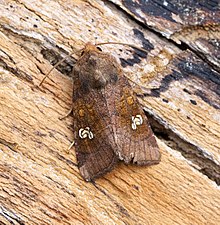
Noctuidae

The Noctuidae, commonly known as owlet moths, cutworms or armyworms, are the most controversial family in the superfamily Noctuoidea because many of the clades are constantly changing, along with the other families of the Noctuoidea. It was considered the largest family in Lepidoptera for a long time, but after regrouping Lymantriinae, Catocalinae and Calpinae within the family Erebidae, the latter holds this title now. Currently, Noctuidae is the second largest family in Noctuoidea, with about 1,089 genera and 11,772 species. However, this classification is still contingent, as more changes continue to appear between Noctuidae and Erebidae. Adult: Most noctuid adults have drab wings, but some subfamilies such as Acronictinae and Agaristinae are very colorful, especially those from tropical regions (e.g. Baorisa hieroglyphica). They are characterized by a structure in the metathorax called the nodular sclerite or epaulette, which separates the tympanum and the conjunctiva in the tympanal organ. It functions to keep parasites (Acari) out of the tympanal cavity. Another characteristic in this group is trifine hindwing venation, by reduction or absence of the second medial vein (M2). Larva: Commonly green or brown; however, some species present bright colors, such as the Camphorweed cucullia moth (Cucullia alfarata). Most are pudgy and smooth with rounded short heads and few setae, but there are some exceptions in some subfamilies (e.g. Acronictinae and Pantheinae). Pupa: The pupae most often range from shiny brown to dark brown. When they newly pupate they are bright brownish orange, but after a few days start to get darker. Eggs: Vary in colors, but all have a spherical shape. The word Noctuidae is derived from the name of the type genus Noctua, which is the Latin name for the little owl, and the patronymic suffix -idae used typically to form taxonomic family names in animals. The common name 'owlet' originally means a small or young owl. The names 'armyworms' and 'cutworms' are based on the behavior of the larvae of this group, which can occur in destructive swarms and cut the stems of plants. This family is cosmopolitan and can be found worldwide except in the Antarctic region. However, some species such as the Setaceous Hebrew character (Xestia c-nigrum) can be found in the Arctic Circle, specifically in the Yukon territory of western Canada, with an elevation 1,702 m above sea level, where the temperature fluctuates between 23/-25 °C (73/-13 °F). Many species of dart moths have been recorded in elevations as high as 4,000 m above sea level (e.g. Xestia elisabetha).
